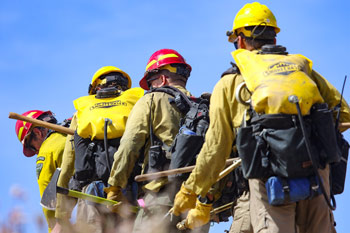Click Here for California Fires
July 10, 2024 - Currently, 76 large active wildfires are being managed nationwide, and have burned 543,211 acres. Of these, 28 wildfires are being managed under full  suppression strategies. 12,776 wildland firefighters and support personnel are assigned to incidents across the country. Evacuation orders are in effect for residents near the Lake, Vista, Shelly and Basin fires in California, the Silver King Fire in Utah, the Pioneer Fire in Washington, the Larch Creek Fire in Oregon, and the Pius fire in Arizona.
suppression strategies. 12,776 wildland firefighters and support personnel are assigned to incidents across the country. Evacuation orders are in effect for residents near the Lake, Vista, Shelly and Basin fires in California, the Silver King Fire in Utah, the Pioneer Fire in Washington, the Larch Creek Fire in Oregon, and the Pius fire in Arizona.
Significant wildland fire activity continues to increase in several geographic areas. Predictive services report that the potential for additional large wildland fires to emerge over the next several days is high. The National Interagency Coordination Center has increasingly engaged with geographic area coordination centers to coordinate and fill orders for all national resource types daily. Drawdown of multiple resource types on less active geographic areas is occurring. Due to these factors, the national preparedness level (PL) increased to PL4 at 07:30 this morning.
There is a fuels and fire behavior advisory spanning from central Alaska into the northeast Interior to the border with Canada. There is also a fuels and fire behavior advisory issued for California that highlights abnormally high fine fuel loading across the state. Residents, travelers, or workers on their ways to these states should be advised and familiarize themselves with the elevated risks.
The national predictive services staff at the National Interagency Coordination Center released the National Significant Wildland Fire Potential Outlook for June through September. For additional information about the current outlook visit the Outlook page on the NICC site.
Record-breaking heat is coinciding with very low relative humidity and windy conditions across much of the Western United States, which means that accidental ignitions can spread quickly. If you live in a fire-prone area, especially if your home is adjacent to wildlands, take some steps to make your home more defensible if wildfire should come your way. Create fire breaks with lawns, driveways and walkways and stack firewood away from your home. Make sure your address is visible from the road so emergency responders can see it and ensure you have a plan for your family and pets to evacuate when needed. Check out these sites to help you prepare: https://www.ready.gov/wildfires and https://www.readyforwildfire.org/.
Strong high-pressure centered over the western Great Basin will continue to bring very hot and critically dry conditions to much of the interior western US on Wednesday as it slowly begins to shift eastward. Well-above normal temperatures combined with relative humidities in the single digits to lower teens are expected across multiple geographic areas. Nighttime relative humidity recovery will also be quite poor, especially across the Great Basin. Locally breezy winds are expected across parts of the Inland Northwest, including gusty winds through the Cascade Gaps. Elsewhere, mainly hot and dry weather will persist west of the Continental Divide in the Southwest while the coverage of wetting showers and thunderstorms gradually increases from eastern Arizona into New Mexico. The remnants of Beryl will continue to move along a cold front through the Great Lakes and Northeast with heavy rainfall, while isolated thunderstorms continue well ahead of the front across the Southeast and Mid- Atlantic, although most areas will receive little to no rainfall. Most of mainland Alaska has received several bouts of wetting rain over the last several days; however, temperatures will warm back closer to seasonal normal with generally dry weather for the interior.
| Number of new large fires or emergency response * New fires are identified with an asterisk |
4 | States currently reporting large fires: |
| Number of active large fires Total does not include individual fires within complexes. |
71 | |
| Acres from active fires | 664,112 | |
| Fires contained | 2 |
Year-to-date statistics
| 2024 (1/1/24-7/10/24) | Fires: 23,584 | Acres: 2,856,187 |
| 2023 (1/1/23-7/10/23) | Fires: 25,643 | Acres: 731,388 |
| 2022 (1/1/22-7/10/22) | Fires: 35,711 | Acres: 4,845,027 |
| 2021 (1/1/21-7/10/21) | Fires: 33,491 | Acres: 1,868,143 |
| 2020 (1/1/20-7/10/20) | Fires: 27,114 | Acres: 1,625,127 |
| 2019 (1/1/19-7/10/19) | Fires: 21,807 | Acres: 1,914,670 |
| 2018 (1/1/18-7/10/18) | Fires: 31,991 | Acres: 3,361,715 |
| 2017 (1/1/17-7/10/17) | Fires: 33,158 | Acres: 3,593,400 |
| 2016 (1/1/16-7/10/16) | Fires: 28,244 | Acres: 2,349,415 |
| 2015 (1/1/15-7/10/15) | Fires: 30,541 | Acres: 4,234,826 |
| 2014 (1/1/14-7/10/14) | Fires: 28,271 | Acres: 989,185 |
10-year average Year-to-Date
| 2014-2023 | Fires: 29,367 | Acres: 2,473,198 |
Source: NIFC








